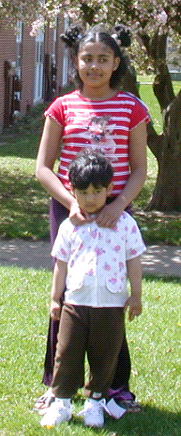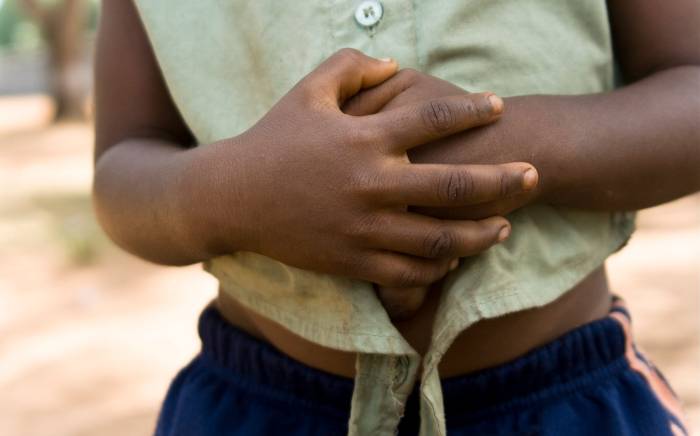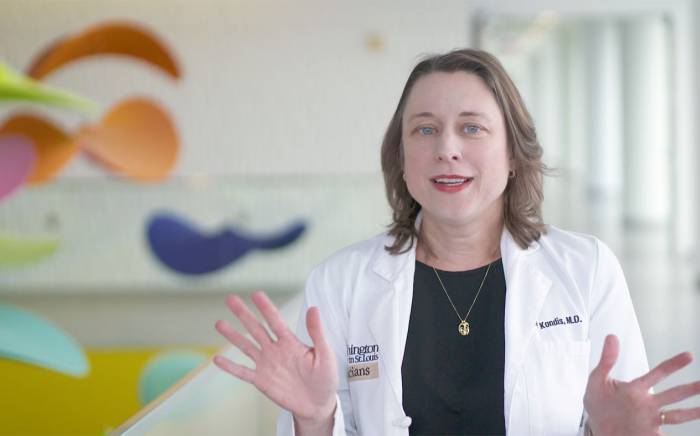They say a picture is worth a thousand words. If that's the case, one of Adiba Islam's most recent masterpieces tells a story about strength, courage and beauty. It's a snapshot of the world through the eyes of this radiant, aspiring artist, and a symbol of her life's journey. It's a picture of a tiger.
Twelve-year-old Adiba's story is well known to the staff of the hematology/oncology unit at St. Louis Children's Hospital. She received a bone marrow transplant here to treat beta thalassemia in April, 2003. Thalassemia is a hereditary blood disorder that causes the destruction of abnormal red blood cells resulting in severe chronic anemia. This can have a devastating effect on growth and development, heart, lungs, bones, liver and other organs.
 Adiba's parents noticed her pale complexion and weak disposition when she was one-year-old. Her doctor performed a blood test and made the diagnosis.
Adiba's parents noticed her pale complexion and weak disposition when she was one-year-old. Her doctor performed a blood test and made the diagnosis.
From that time until age 11, Adiba received regular blood transfusions, which have been the standard of care for thalassemia for years. "Initially, she used to receive the transfusions once every three months," says Adiba's father, Sayed Islam. "Gradually it was once every two months, then once every three weeks."
As it became necessary to transfuse Adiba more frequently, she was subject increasingly to the risk of dangerous side effects associated with chronic transfusion therapy.
"People who receive constant transfusions have an excess of iron in their bodies," explains Dr. Shalini Shenoy, associate director, pediatric bone marrow transplant program at St. Louis Children's Hospital. "This can deposit in, and weaken the liver, heart and other organs."
Adiba was already experiencing liver damage by the time she was 10, despite careful efforts to minimize iron storage with appropriate medications. And when her family learned that her life span would be significantly shorter because of complications of life-long transfusion therapy, they explored other, more innovative treatment options.
Their search brought them to the bone marrow transplant program at St. Louis Children's Hospital, where a new stem cell transplant protocol was helping address the paradox associated with treating children like Adiba; children with chronic diseases and poor outcomes despite medical intervention. A bone marrow transplant could potentially cure her thalassemia -- making the transfusions unnecessary -- but such transplants traditionally are hard to do in thalassemia patients and require chemotherapy, which could be toxic to Adiba's already weakened organs and cause serious side effects.
The new transplant approach developed here at St. Louis Children's Hospital is based on the idea of reducing the dose of chemotherapy, and thus, the side effects of conditioning. "Other centers around the country are now participating in this study with us, based on our success," says Dr. Shenoy, "we were the pioneers."
"Before you perform the transplant, you have to condition the patient, which means you prepare the patient to successfully accept normal stem cells from another person" says Dr. Shenoy. "This particular treatment is designed to achieve this goal with minimum toxicity and side effects."
The conditioning is done through a three-drug process, only one of which is chemotherapy. Dr. Shenoy explains, "The crux of the protocol, unlike other common stem cell transplant procedures, is not so much chemotherapy as it is immune suppression."
Adiba found the perfect bone marrow match in her 3-year-old brother, Akash. And the process of transplanting was much less frightening than she expected. "At first I was scared because I thought maybe it was going to hurt," says ‘Adiba’. "But then I learned it wasn't going to hurt and I just went to sleep."
One year after the transplant, Adiba's body has accepted Akash's stem cells. She has his blood type now. And she is cured altogether of thalassemia.
Furthermore, she has shown no signs of complications related to the transplant. "The one year mark is a major landmark if a side effect or toxicity is going to happen," says Dr. Shenoy. "Most of the time, graft versus host disease or rejection of the graft (in this case Akash’s cells) will happen within that first year."
Adiba says she's feeling great. "I feel like I can do everything better than before I had the transplant."
And she has a special place in her heart for Dr. Shenoy. "She really takes care of me and makes sure nothing happens to me. She's like a mom."
Dr. Shenoy and the successful bone marrow transplant had an unquestionably positive impact on Adiba. But Adiba is credited with leaving her special mark at St. Louis Children's Hospital as well.
 "She is delightful, a pleasure to know," says Dr. Shenoy. "We were all invited into her room to have little chats with her throughout her stay here. And I have to say she's an extremely good artist. My room is filled with her pictures - especially her tiger."
"She is delightful, a pleasure to know," says Dr. Shenoy. "We were all invited into her room to have little chats with her throughout her stay here. And I have to say she's an extremely good artist. My room is filled with her pictures - especially her tiger."
Dr. Shenoy credits Adiba for staying on top of her condition, and keeping a good attitude. "The questions she asked were very insightful. She's wise beyond her years and very intelligent."
Adiba's family also deserves credit for being supportive, and for learning as much as they could about her condition so they could help her recover as quickly, easily and comfortably as possible.
"Everything's good now," says Sayed Islam. "As a father, to see this recovery is wonderful. Now she will have a normal life span, just like my son."
Adiba is planning her future already. She loves anything that has to do with art -- drawing, sculpting. And she gets most of her artistic inspiration from nature or animals. She also plays the violin and hopes one day to be a professional artist or musician.
She's on the right track. "I feel healthier now than ever."
Her favorite doctor agrees. "Now she can look forward to life like anybody else can."












